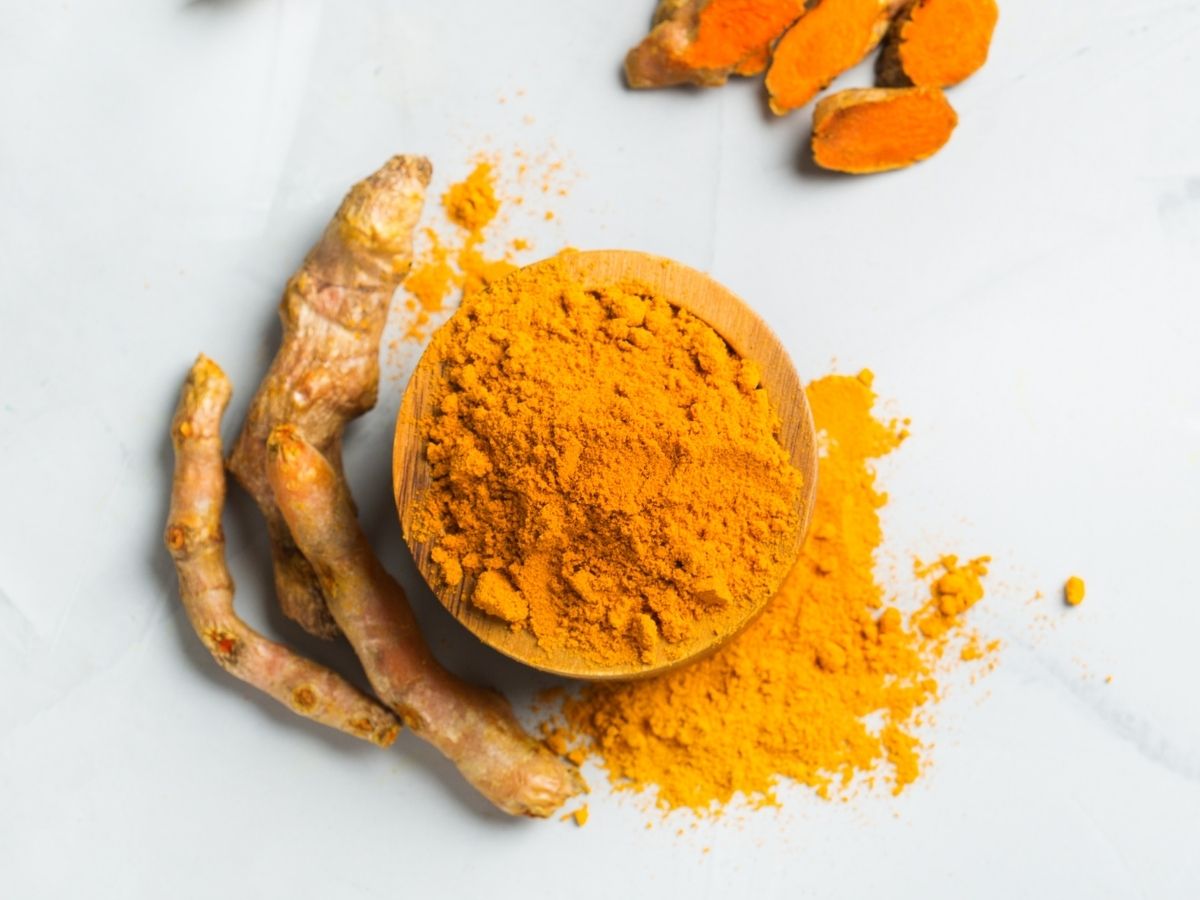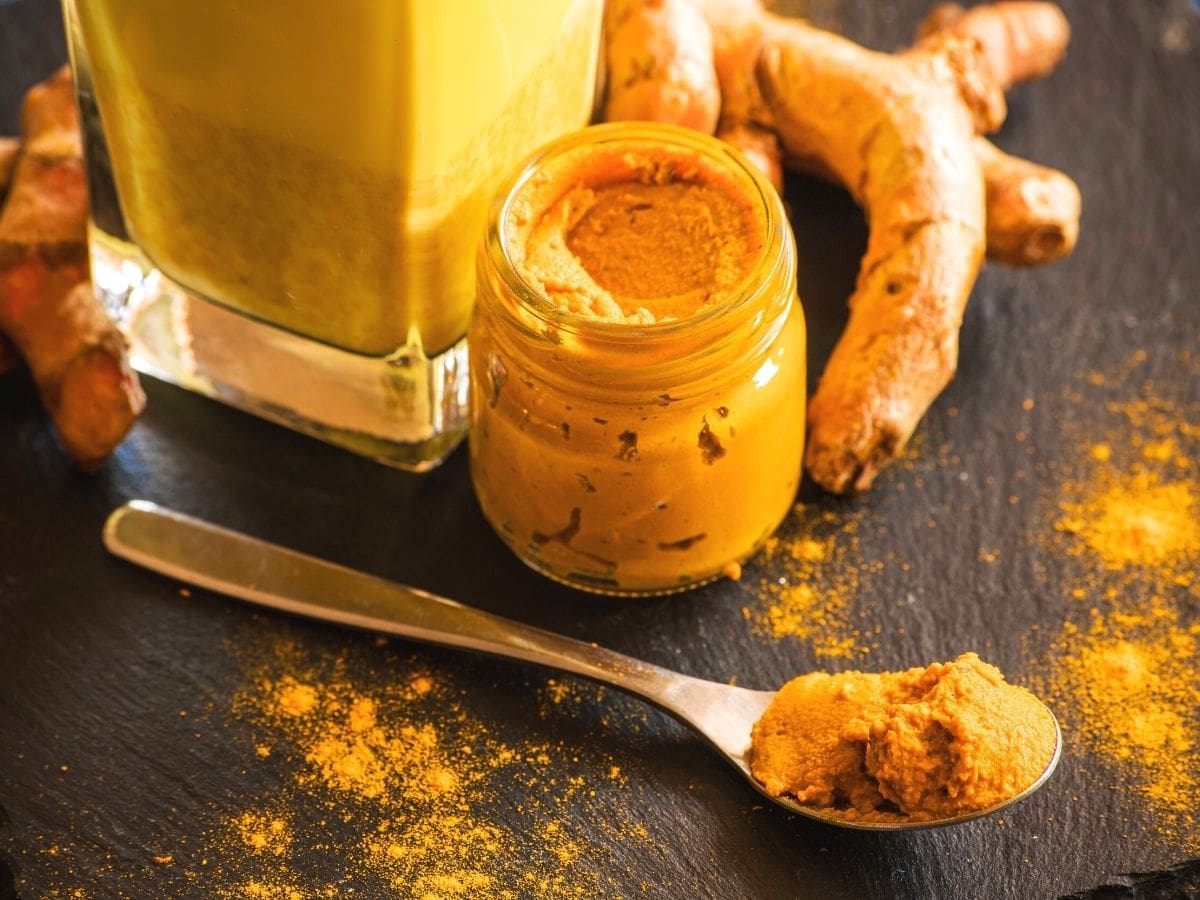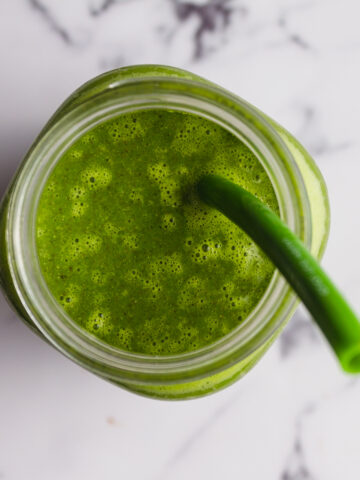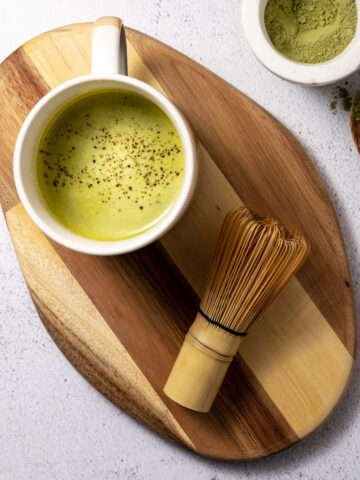If you hang around my blog, you’ll quickly realize that I am a fan of using fresh turmeric root in my recipes. It’s popularity in my kitchen is due to its anti-inflammatory effects and other positive health benefits. Because I buy this root in bulk, I needed to figure out how to properly store it so that I get the most value for my dollar and avoid food waste. Here’s what I discovered.

Fresh turmeric root is easy to store. You can safely store it in a brown paper bag in the refrigerator for up to two weeks or in your freezer for up to six months. When it’s close to expiration, you can dehydrate the fresh turmeric to make a dried turmeric powder.
While that sounds straightforward, there are a few things you should know about each of the methods listed above. Read on for all the details you need to successfully preserve your raw turmeric root.
How to store fresh turmeric root in the refrigerator
Turmeric root stores well in the refrigerator if kept dry.
Follows these steps to get started:
- Scrub the turmeric root using a brush or your fingers. Like other produce, is crucial to clean the turmeric root before storing and consuming. This significantly reduces the residues left on them along their journey to your home. From dirt to pesticides to germs, you’ll want to eliminate all debris. Note that you don’t have to remove the skin if you properly wash it. It’s only removed before consuming to help eliminate bacteria and debris.
- Use a paper towel to pat the turmeric root dry. The big thing to watch out for with fresh turmeric is mold growth. The best way to avoid this is to ensure they’re completely dry before refrigerating.
- Store in a brown paper bag. A brown paper bag works well at absorbing excess moisture, again avoiding mold growth on the turmeric. If you don’t have a brown paper bag, no worries. Simply wrap the root in a paper towel and store in a plastic bag. The paper towel will also serve the same purpose as the paper bag, soaking up extra humidity.
It’s that simple. If you’re getting close to two weeks in the fridge, you may want to consider freezing the remaining turmeric so it doesn’t go to waste.
Tip: Turmeric can stain surfaces and skin easily. Be sure to wash the cutting board and peeler quickly to avoid permanent stains. Lemon juice can help remove stains from your skin if needed.
How to freeze fresh turmeric root
Can you freeze turmeric root? Yes. Turmeric root freezes well, but it will lose some of its firmness when it thaws.
Follows these steps to get started:
- Scrub the turmeric root using a brush or your fingers. If you’re freezing fresh turmeric that was previously refrigerated and followed my steps above, you’re in good shape. If you’re going straight to the freezer, then listen up: scrub your turmeric diligently. You don’t want to freeze with any residue or germs on the skin.
- Cut into cubes. Cut the turmeric root into one inch pieces. These will be large enough for a single portion, but small enough that you won’t be wasting excess turmeric root that’s defrosted.
- Wrap in a paper towel and place in a freezer bag. Similar to the refrigeration method, you’ll want to wrap raw turmeric in a paper towel to ensure you’re soaking up excess moisture in the root or the air. Then place in a freezer bag and squeeze out air before sealing to avoid freezer burn. Write the date in a permanent marker and be sure to consume it within six months. .
When you’re ready to use your frozen turmeric root, remove it from the freezer. You can let it thaw for 5 before use if you want to use the whole root. If you only want to use part of the root, use a grater to grate part of it into your dish.
Tip: Only remove from the freezer when you’re ready to use the turmeric root. It will start to defrost immediately. If returned to the freezer it will compromise the quality.
How to make turmeric powder in the oven
Instead of discarding or freezing your fresh turmeric root, you can use your oven to turn raw turmeric into a powder that will last up to one year.

Here’s how:
- Rinse the turmeric root. You don’t need to be diligent in scrubbing because you’ll be peeling the skin off to make turmeric powder. But, give the roots a quick rinse.
- Use a vegetable peeler to remove the skin off the turmeric root. Turmeric root can be a little tough to peel because it has knobs, much like ginger. I find it easier to cut these knobs off rather than peel around them. Find a technique that works for you and don’t stress if there’s a little bit of skin left on the root.
- Cut the root into uniform, thin slices. Thin slices will help the root dry more quickly and evenly.
- Arrange the slices on a baking tray lined with baking paper. Spread evenly and avoid overlap.
- Bake in the oven at 200 degrees F for 2 hours.
- Add slices to a food processor or grinder and grind into a fine powder. Please note that this may stain your equipment.
- Place in a spice jar and store in a cool, dark cupboard for up to one year.
Tip: Wear gloves when slicing the turmeric root to avoid yellow-stained skin.
Turmeric root vs powder
Dried turmeric is made by peeling, boiling, drying and grinding the fresh turmeric root. During this process, turmeric loses some of its oils and pungency. So in my opinion, fresh turmeric is best for our health and provides the best flavour. But, turmeric powder can be more convenient and significantly less messy, so it has its place too.
Here are the things you want to consider when buying either variety.
When purchasing turmeric root:
- Look for turmeric in the produce section of the grocery store, often placed near the ginger root. Choose a firm piece, avoiding soft, dried and shriveled turmeric.
When purchasing turmeric powder:
- Ensure it’s a high quality variety. It’s often helpful to go to ethnic and specialty spice shops that have fresher stock that turns over more quickly. Cheaper turmeric powder has a strong, bitter taste that may turn you off this root altogether.
Cooking with turmeric root

Now that you know everything about storing and buying turmeric, it's time to start cooking with it.
I’ll share some of my favourite recipes using fresh turmeric below. But to make you the master of your own kitchen, I want to share a few ideas on how you can consider using fresh or frozen turmeric.
- Juices and smoothies. Turmeric root has a strong flavour that can add a kick to your beverage. It’s a great way to use turmeric daily to get the anti-inflammatory health benefits. Check out my go-to turmeric including smoothie below.
- Homemade tea. Bring water and a chunk of turmeric root to boil on the stovetop. Reduce heat and simmer for 10 minutes. I also like to throw ginger root in the pot for a delicious ginger-turmeric tea.
- Golden milk latte. These have jumped in popularity over the last few years. They’re made by blending plant-based milk with turmeric root, nutmeg and cinnamon. This is one of my favourite recipes.
- In cooking: Raw turmeric can be used in place of turmeric powder. One inch of fresh turmeric root is equal to one tablespoon of grated turmeric root is equal to one teaspoon of powdered one. While it works best in curries and Indian cuisine, it’s also delicious to grate on roasted vegetables, add to soups, or in Mediterranean dips.
1 inch fresh turmeric = 1 tablespoon freshly grated turmeric = 1 teaspoon ground turmeric
Check out my go-to turmeric recipes below:






H. Weaver
Great tip about the paper bag. I needed this article to remind me because I just purchased a pound of turmeric from a farm stand that I don't want to waste. Normally I grow my own and only harvest as needed.
I have to ask because it's bugging me, I am extremely curious about the pictures of Ginger root. Why use 2 different pictures of Ginger root in an article about Turmeric? I did see a couple mentions about ginger. One was comparing for similarities and the other was to add a piece to the turmeric tea to give it a kick.
But to me that doesn't warrant those pictures.
Caitey Jay
Hi there! I'm so glad that you found this article a helpful resource for storing turmeric. Also, thanks for reaching out about the pictures. I've updated the images thanks to feedback from yourself and others. The last thing I want is to confuse people with vaguely tied images. Happy to have an audience who shares this back with me. Thanks again!
Hairstyles VIP
Hi would you mind letting me know which webhost you're using? I've loaded your blog in 3 completely different web browsers and I must say this blog loads a lot faster then most. Can you suggest a good hosting provider at a fair price? Thanks a lot, I appreciate it!
https://www.hairstylesvip.com
Caitey Jay
Hi there! No problem. I switched to BigScoots last year and they've been phenomenal for service and pagespeed. I highly recommend them.
Cat
Hi Caitey,
When making turmeric powder from frozen turmeric do you have to let it thaw out before starting the drying process?
Caitey Jay
Hi Cat! I haven't tried dehydrating turmeric from frozen. But, I just did a little research, and it looks like you can. The only thing to note is that it may take a little longer to dehydrate due to the higher water content. Let me know if you do try it.
Sahadevan N
How can preserve a large
qty of fresh turmeric ? How we can learn the quantity of turmeric